Surface Reflectance and Aerosol Retrieval from SPOT-VGT and PROBA-V in the Mission Exploitation Platform Environment
Abstract
:1. Introduction
2. Materials and Methods
2.1. Data Archive
2.1.1. Description of the MEP Archive
2.1.2. Harmonization Method
2.1.3. Harmonization Results
2.2. Method: The CISAR Algorithm
2.2.1. Algorithm Features
2.2.2. Product Definition
2.2.3. Algorithm Performances Evaluation
- Accuracy (A):
- Precision (P):
- Uncertainty (U)where n is the number of points, and is the difference between the retrieved and the reference values. The uncertainty defined in Equation (3) corresponds to the root mean square error (RMSE). Additionally, the correlation coefficient is calculated. The choice of the APU statistics to evaluate the algorithm performances is made to assure consistency with the PV-LAC ESA project [7]. When comparing against ground-based measurements obtained from the aerosol robotic network (AERONET [29]), satellite observations are collocated within a ±30-min temporal window. As the AOT is not delivered at 550 nm in the AERONET dataset, the AOT is extrapolated at the wavelength of interest using the Angstrom exponent obtained from AERONET measurements in the 440 and 670 nm. Similar validation exercises of CISAR applied to satellite observations can be found in [8,21].
3. Results
3.1. Analysis of 20-Year Time Series over Key Areas
3.2. Global Processing at 5 km Resolution
- If the 80% of sub-pixels are cloud-free only cloud-free observations are aggregated and the cloud mask is set to 0.
- If the 80% of sub-pixels are cloudy only cloudy observations are aggregated and the cloud mask is set to 1.
- Otherwise, all pixels are aggregated and the cloud mask is a number between 0 and 1, indicating the percentage of cloudy pixels.
3.2.1. AOT: Evaluation against Ground Observation
3.2.2. AOT: Monthly Mean Evaluation
3.2.3. Case Study 1: Australian Fires
3.2.4. Case Study 2: Surface Albedo over North Africa
4. Discussion
5. Conclusions
Supplementary Materials
Author Contributions
Funding
Data Availability Statement
Conflicts of Interest
References
- Merchant, C.J.; Embury, O.; Rayner, N.A.; Berry, D.I.; Corlett, G.K.; Lean, K.; Veal, K.L.; Kent, E.C.; Llewellyn-Jones, D.T.; Remedios, J.J.; et al. A 20 Year Independent Record of Sea Surface Temperature for Climate from Along-Track Scanning Radiometers. J. Geophys. Res. Ocean. 2012, 117. Available online: https://onlinelibrary.wiley.com/doi/pdf/10.1029/2012JC008400 (accessed on 22 October 2023). [CrossRef]
- Dierckx, W.; Sterckx, S.; Benhadj, I.; Livens, S.; Duhoux, G.; Van Achteren, T.; Francois, M.; Mellab, K.; Saint, G. PROBA-V mission for global vegetation monitoring: Standard products and image quality. Int. J. Remote Sens. 2014, 35, 2589–2614. [Google Scholar] [CrossRef]
- Goor, E.; Dries, J.; Daems, D.; Paepen, M.; Niro, F.; Goryl, P.; Mougnaud, P.; Della Vecchia, A. PROBA-V Mission Exploitation Platform. Remote Sens. 2016, 8, 564. [Google Scholar] [CrossRef]
- Copernicus Climate Change Service (C3S). Available online: https://climate.copernicus.eu/ (accessed on 4 April 2023).
- Carrer, D.; Smets, B.; Ceamanos, X.; Roujean, J. Copernicus Global Land Operations: Vegetation and Energy. Algorithm Theoretical Basis Document. Surface Albedo 1 km. 2018. Available online: https://land.copernicus.eu/global/sites/cgls.vito.be/files/products/CGLOPS1_ATBD_SA1km-V1_I2.11.pdf (accessed on 22 October 2023).
- Ramon, D.; Jolivet, D.; Elias, T.; Compiègne, M. Algorithm Theoretical Basis Document: Atmospheric Correction. 2021. Available online: https://proba-v.vgt.vito.be/sites/probavvgt/files/downloads/PROBA-V_C2_Atmospheric_Correction_ATBD.pdf (accessed on 22 October 2023).
- Wolters, E.; Luffarelli, M.; Govaerts, Y.; Swinnen, E. PV-LAC: D6-A2, Aerosol Optical Thickness and Surface Reflectance Validation Report V2. 2018. Available online: https://earth.esa.int/eogateway/documents/20142/37627/PV-LAC-ATMO-validation-report-v2.pdf (accessed on 22 October 2023).
- Luffarelli, M.; Govaerts, Y. Joint retrieval of surface reflectance and aerosol properties with continuous variation of the state variables in the solution space—Part 2: Application to geostationary and polar-orbiting satellite observations. Atmos. Meas. Tech. 2019, 12, 791–809. [Google Scholar] [CrossRef]
- Dierickx, F. Chapter 6 Climate Change Uncertainties|Copernicus Climate Change Programme: User Learning Service Content. 2019. Available online: https://bookdown.org/floriandierickx/bookdown-demo/climate-change-uncertainties.html (accessed on 22 October 2023).
- Mittaz, J.; Merchant, C.J.; Woolliams, E.R. Applying principles of metrology to historical Earth observations from satellites. Metrologia 2019, 56, 032002. [Google Scholar] [CrossRef]
- Giering, R.; Quast, R.; Mittaz, J.P.D.; Hunt, S.E.; Harris, P.M.; Woolliams, E.R.; Merchant, C.J. A Novel Framework to Harmonise Satellite Data Series for Climate Applications. Remote Sens. 2019, 11, 1002. [Google Scholar] [CrossRef]
- Wolters, E.; Swinnen, E.; Toté, C.; Sterckx, S. SPOT-VGT Collection 3 Products User Manual 2016. Available online: https://publications.vito.be/2016-1034-spotvgt-collection-3-products-user-manual-v10.pdf (accessed on 22 October 2023).
- Wolters, E.; Dierckx, W.; Iordache, M.D.; Swinnen, E. PROBA-V Collection 1 User Manual 2023. Available online: https://proba-v.vgt.vito.be/sites/probavvgt/files/Products_User_Manual.pdf (accessed on 22 October 2023).
- Sterckx, S.; Adriaensen, S.; Dierckx, W.; Bouvet, M. In-Orbit Radiometric Calibration and Stability Monitoring of the PROBA-V Instrument. Remote Sens. 2016, 8, 546. [Google Scholar] [CrossRef]
- Merchant, C.J.; Paul, F.; Popp, T.; Ablain, M.; Bontemps, S.; Defourny, P.; Hollmann, R.; Lavergne, T.; Laeng, A.; de Leeuw, G.; et al. Uncertainty information in climate data records from Earth observation. Earth Syst. Sci. Data 2017, 9, 511–527. [Google Scholar] [CrossRef]
- Govaerts, Y.M. Sand Dune Ridge Alignment Effects on Surface BRF over the Libya-4 CEOS Calibration Site. Sensors 2015, 15, 3453–3470. [Google Scholar] [CrossRef]
- Govaerts, Y.; Sterckx, S.; Adriaensen, S. Use of simulated reflectances over bright desert target as an absolute calibration reference. Remote Sens. Lett. 2013, 4, 523–531. [Google Scholar] [CrossRef]
- Inness, A.; Ades, M.; Agustí-Panareda, A.; Barré, J.; Benedictow, A.; Blechschmidt, A.M.; Dominguez, J.J.; Engelen, R.; Eskes, H.; Flemming, J.; et al. The CAMS reanalysis of atmospheric composition. Atmos. Chem. Phys. 2019, 19, 3515–3556. [Google Scholar] [CrossRef]
- Govaerts, Y.; Nollet, Y.; Leroy, V. Radiative Transfer Model Comparison with Satellite Observations over CEOS Calibration Site Libya-4. Atmosphere 2022, 13, 1759. [Google Scholar] [CrossRef]
- Emde, C.; Buras-Schnell, R.; Kylling, A.; Mayer, B.; Gasteiger, J.; Hamann, U.; Kylling, J.; Richter, B.; Pause, C.; Dowling, T.; et al. The libRadtran software package for radiative transfer calculations (version 2.0.1). Geosci. Model Dev. 2016, 9, 1647–1672. [Google Scholar] [CrossRef]
- Luffarelli, M.; Govaerts, Y.; Franceschini, L. Aerosol Optical Thickness Retrieval in Presence of Cloud: Application to S3A/SLSTR Observations. Atmosphere 2022, 13, 691. [Google Scholar] [CrossRef]
- Rahman, H.; Pinty, B.; Verstraete, M.M. Coupled surface-atmosphere reflectance (CSAR) model. 2. Semiempirical surface model usable with NOAA Advanced Very High Resolution Radiometer Data. J. Geophys. Res. 1993, 98, 20791–20801. [Google Scholar] [CrossRef]
- Cox, C.; Munk, W. Measurement of the Roughness of the Sea Surface from Photographs of the Sun’s Glitter. J. Opt. Soc. Am. 1954, 44, 838–850. [Google Scholar] [CrossRef]
- Hersbach, H.; Bell, B.; Berrisford, P.; Hirahara, S.; Horányi, A.; Muñoz-Sabater, J.; Nicolas, J.; Peubey, C.; Radu, R.; Schepers, D.; et al. The ERA5 global reanalysis. Q. J. R. Meteorol. Soc. 2020, 146, 1999–2049. [Google Scholar] [CrossRef]
- Levy, R.C.; Mattoo, S.; Munchak, L.A.; Remer, L.A.; Sayer, A.M.; Patadia, F.; Hsu, N.C. The Collection 6 MODIS aerosol products over land and ocean. Atmos. Meas. Tech. 2013, 6, 2989–3034. [Google Scholar] [CrossRef]
- Lyapustin, A.; Wang, Y.; Korkin, S.; Huang, D. MODIS Collection 6 MAIAC Algorithm. Atmos. Meas. Tech. 2018, 11, 5741–5765. [Google Scholar] [CrossRef]
- Bevan, S.; North, P.; Los, S.; Grey, W. A global dataset of atmospheric aerosol optical depth and surface reflectance from AATSR. Remote Sens. Environ. 2012, 116, 199–210. [Google Scholar] [CrossRef]
- Claverie, M.; Vermote, E.F.; Franch, B.; Masek, J.G. Evaluation of the Landsat-5 TM and Landsat-7 ETM+ surface reflectance products. Remote Sens. Environ. 2015, 169, 390–403. [Google Scholar] [CrossRef]
- Giles, D.M.; Holben, B.N.; Eck, T.F.; Smirnov, A.; Sinyuk, A.; Schafer, J.; Sorokin, M.G.; Slutsker, I. Aerosol Robotic Network (AERONET) Version 3 Aerosol Optical Depth and Inversion Products. In Proceedings of the AGU Fall Meeting Abstracts, New Orleans, Louisiana, 11–15 December 2017; Volume 2017, p. A11O-01. [Google Scholar]
- Swinnen, E. PROBA-V Collection 2 Algorithm Change Document 2023. Available online: https://proba-v.vgt.vito.be/sites/probavvgt/files/downloads/PROBA-V_C2_Algorithm_Change_Document.pdf (accessed on 22 October 2023).
- Fensholt, R.; Nielsen, T.T.; Stigsen, S. Evaluation of AVHRR PAL and GIMMS 10-day composite NDVI time series products using SPOT-4 vegetation data for the African continent. Int. J. Remote Sens. 2006, 27, 2719–2733. [Google Scholar] [CrossRef]
- Swinnen, E.; Veroustraete, F. Extending the SPOT-VEGETATION NDVI Time Series (1998–2006) Back in Time with NOAA-AVHRR Data (1985–1998) for Southern Africa. IEEE Trans. Geosci. Remote Sens. 2008, 46, 558–572. [Google Scholar] [CrossRef]
- Swinnen, E.; Toté, C. Copernicus Global Land Operations “Vegetation and Energy”. 2020. Available online: https://land.copernicus.eu/global/sites/cgls.vito.be/files/products/CGLOPS1_QAR_NDVI1km-V3_I1.10.pdf (accessed on 22 October 2023).
- Buffo, A.; Alopaeus, V. Experimental determination of size distributions: Analyzing proper sample sizes. Meas. Sci. Technol. 2016, 27, 045301. [Google Scholar] [CrossRef]
- Janjai, S.; Núñez, M.; Masiri, I.; Wattan, R.; Buntoung, S.; Jantarach, T.; Promsen, W. Aerosol Optical Properties at Four Sites in Thailand. Atmos. Clim. Sci. 2012, 2, 441. [Google Scholar] [CrossRef]
- Lyapustin, A.Y.W. Mcd19a3 Modis/Terra+Aqua Brdf Model Parameters 8-Day l3 Global 1 km Sin Grid V006; Technical Report; NASA EOSDIS Land Processes Distributed Active Archive Center: Sioux Falls, SD, USA, 2018.
- Errera, Q.; Bennouna, Y.; Schulz, M.; Eskes, H.; Basart, S.; Benedictow, A.; Blechschmidt, A.M.; Chabrillat, S.; Clark, H.; Cuevas, E.; et al. Validation Report of the CAMS Global Reanalysis of Aerosols and Reactive Gases, Years 2003–2020; Copernicus Atmosphere Monitoring Service: Reading, UK, 2021. [Google Scholar] [CrossRef]
- Mackin, S.; Settle, J.; Warner, J.; Ramsay, A. Statistically Based Approach for Estimation of Sensor Performance Indicators. 2020. Available online: https://earth.esa.int/eogateway/documents/20142/1484253/Statistically-based-approach-for-estimation-of-sensor-performance-indicators-status-and-way-forward.pdf (accessed on 22 October 2023).
- Popp, T.; Mittaz, J. Systematic Propagation of AVHRR AOD Uncertainties—A Case Study to Demonstrate the FIDUCEO Approach. Remote Sens. 2022, 14, 875. [Google Scholar] [CrossRef]
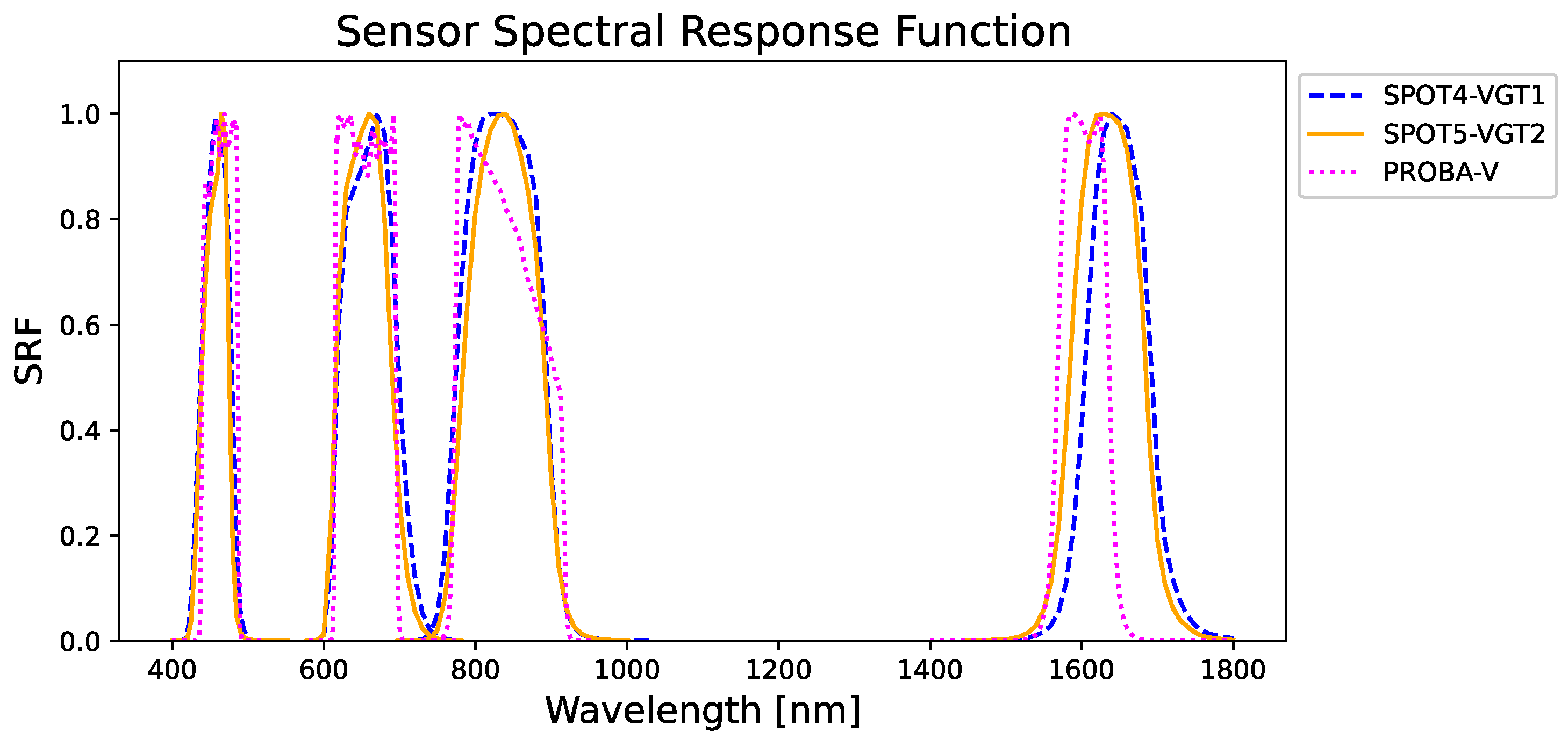
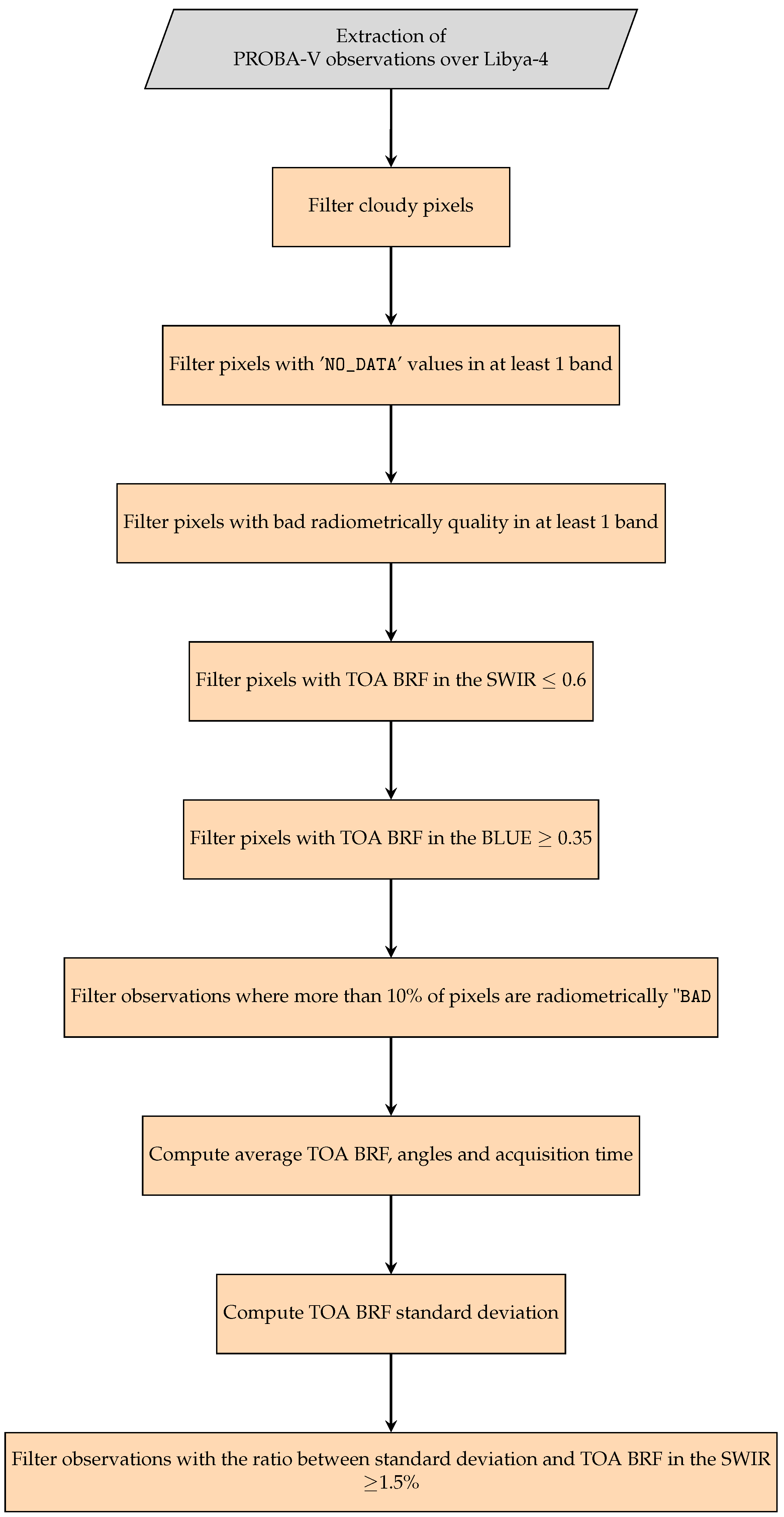
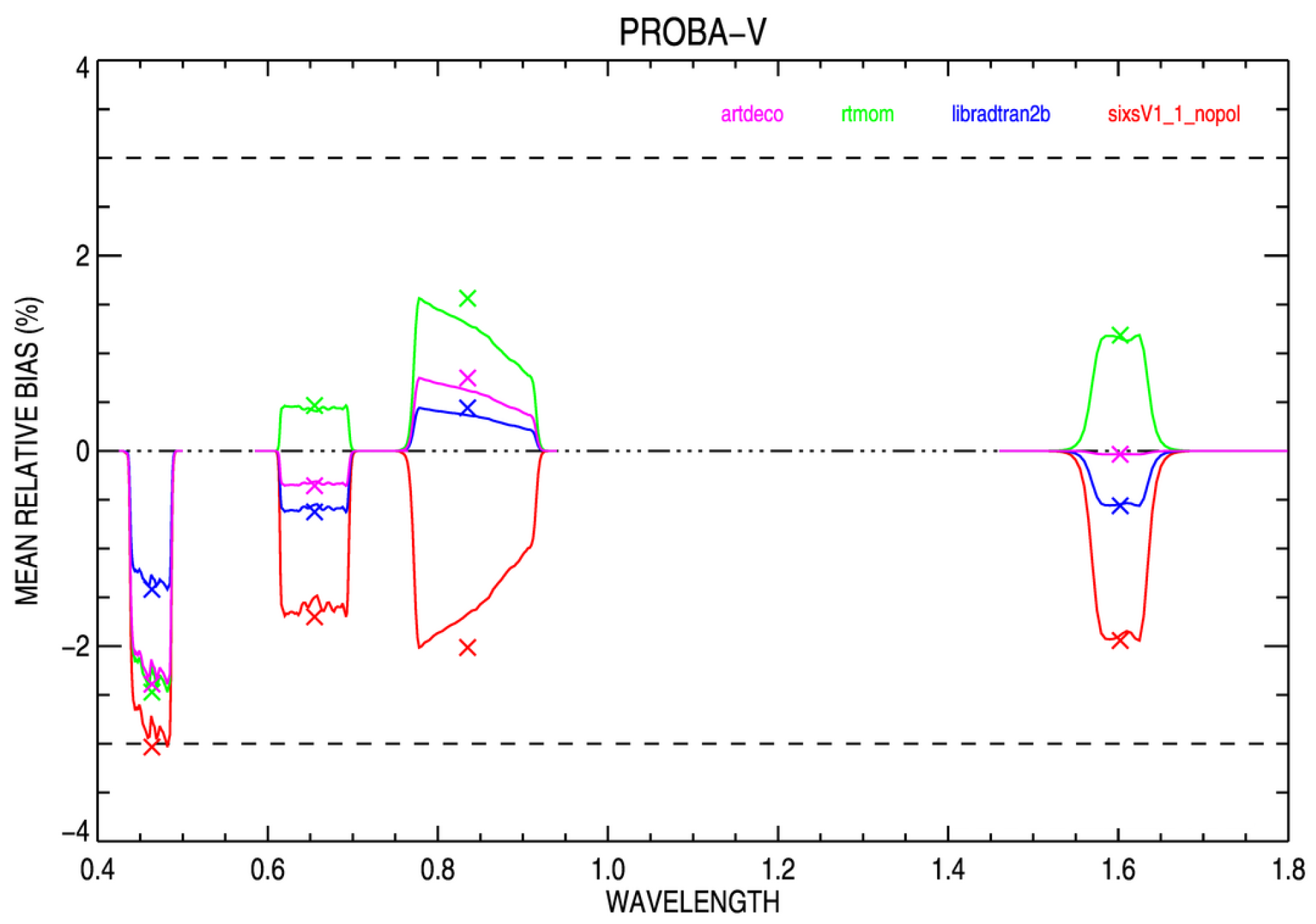

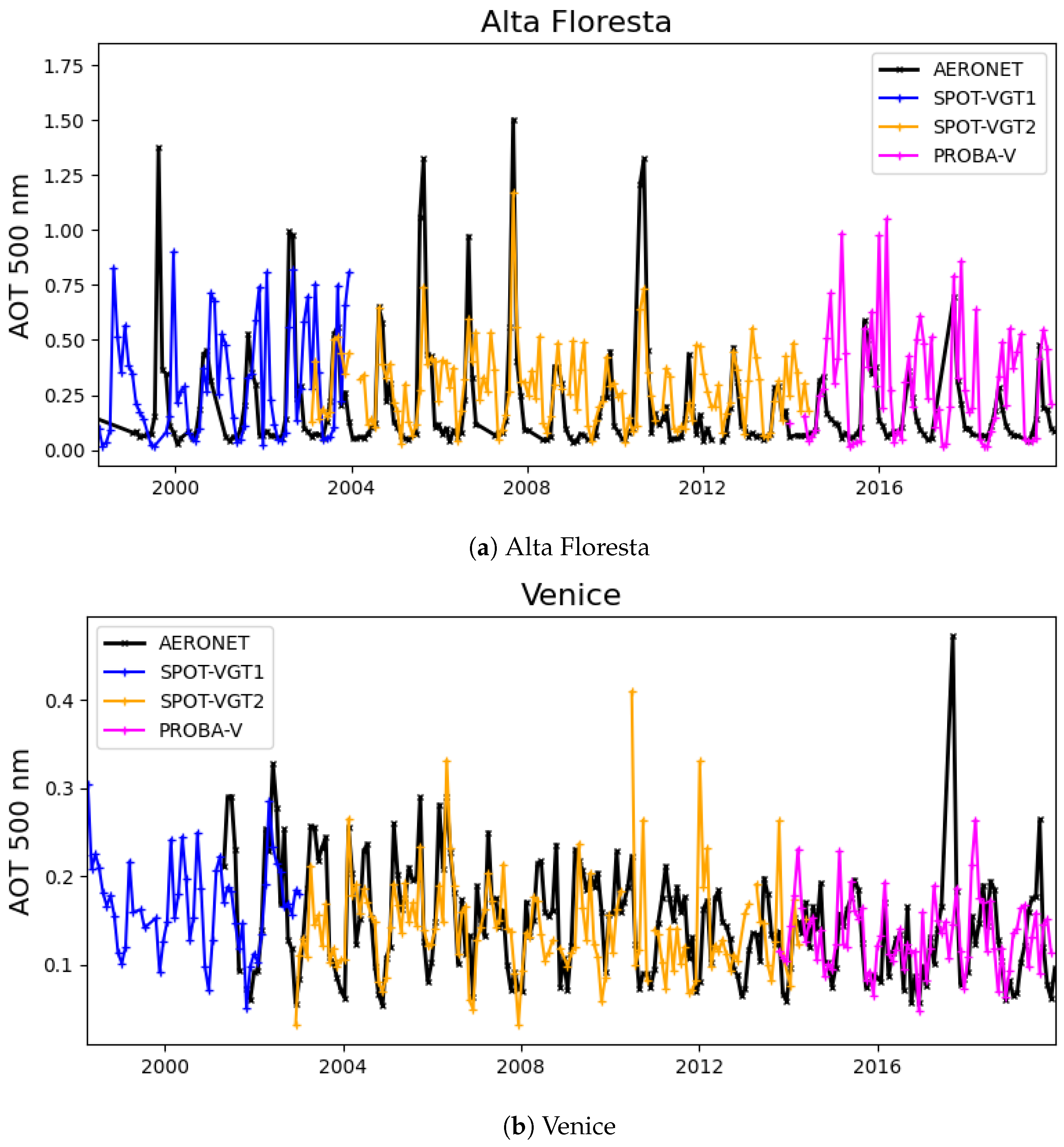
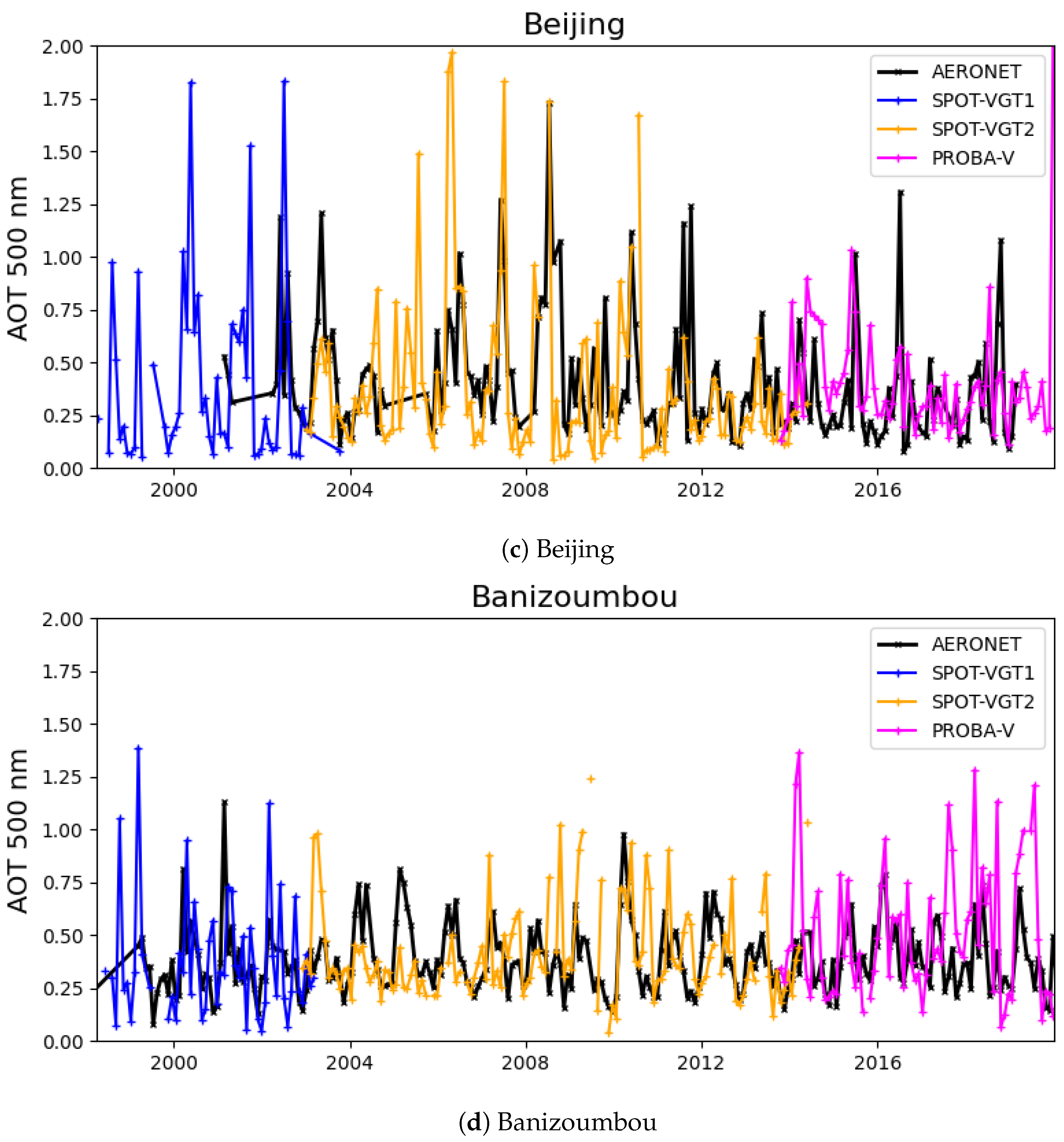
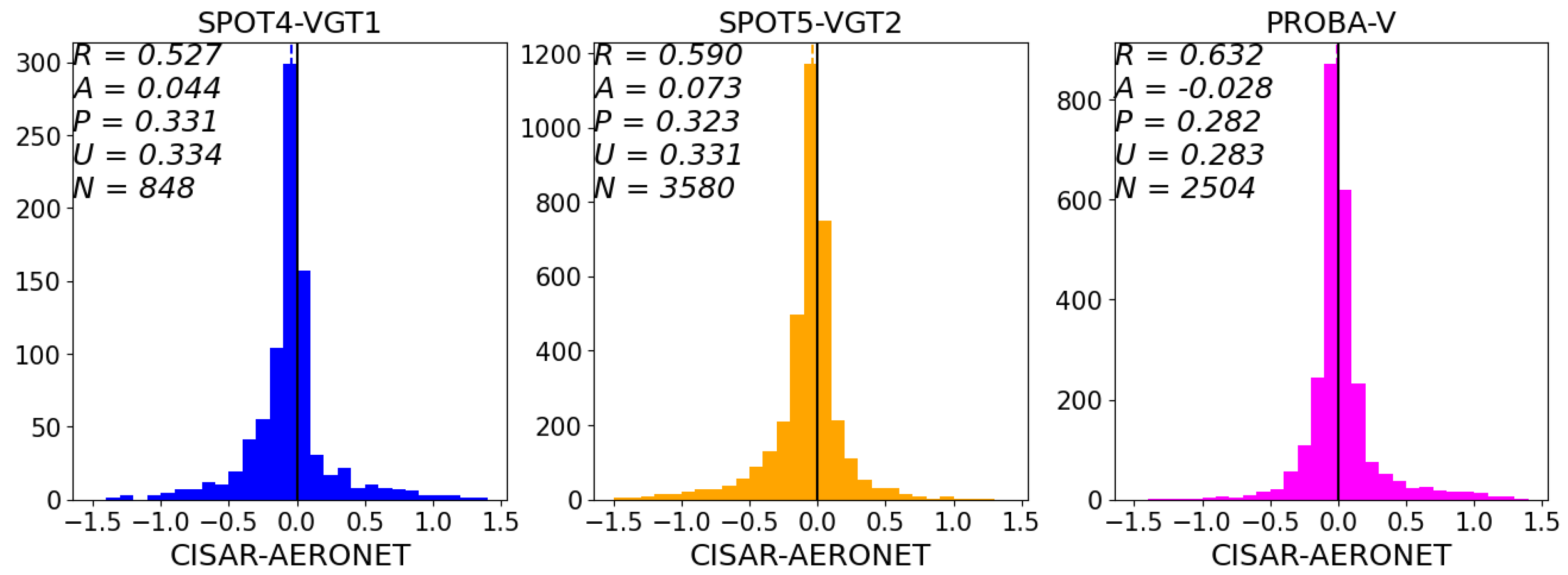
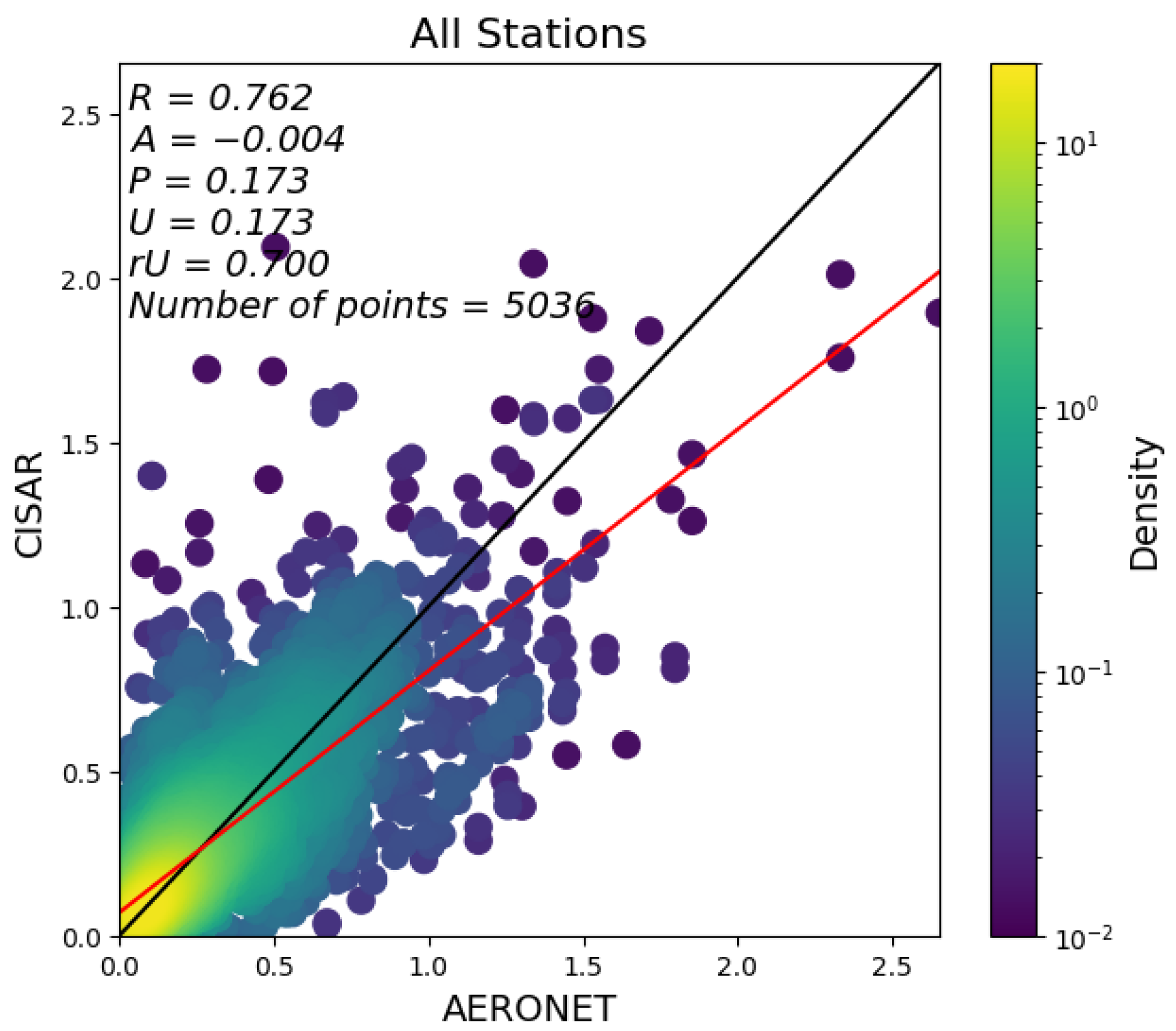


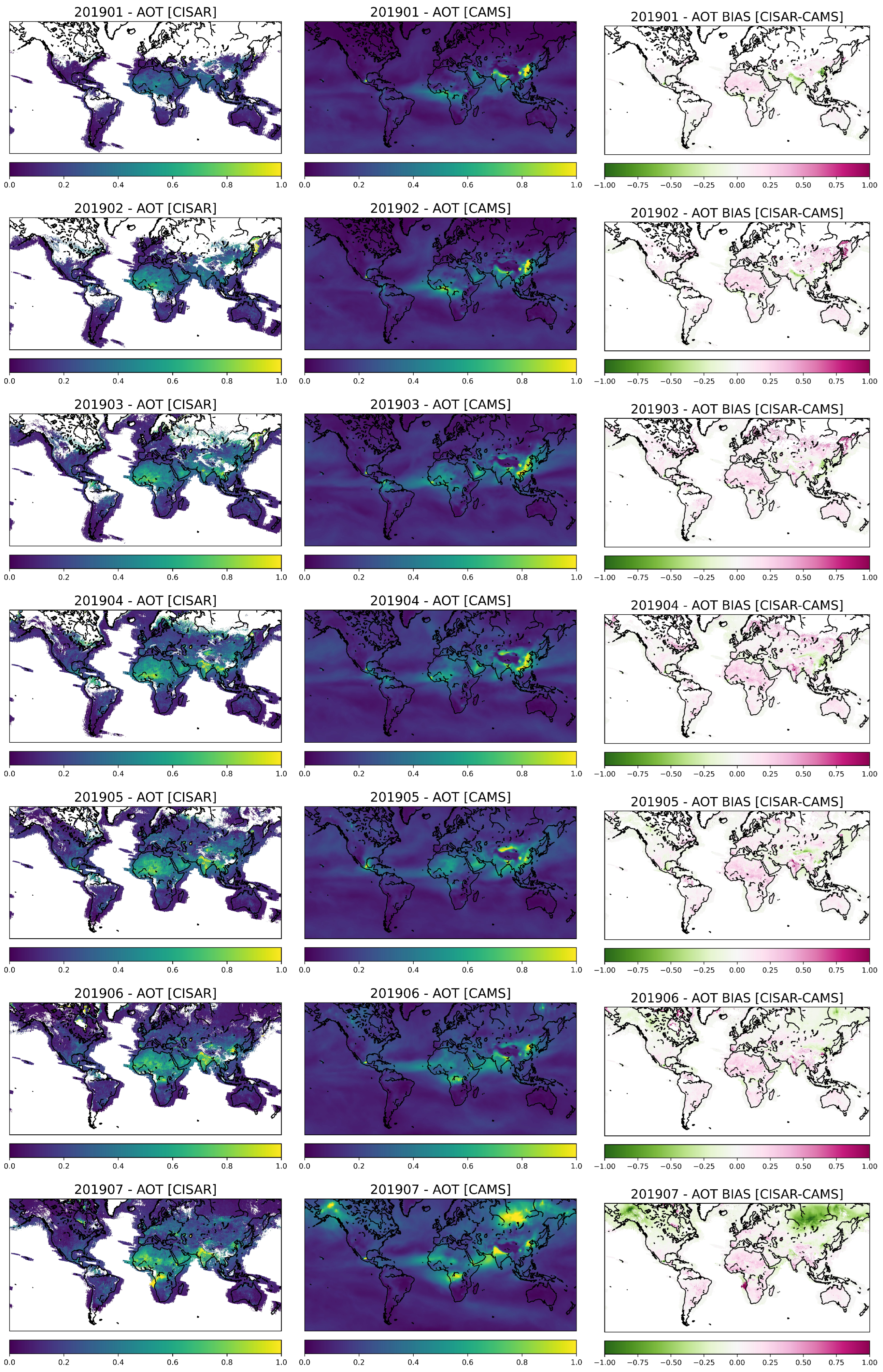

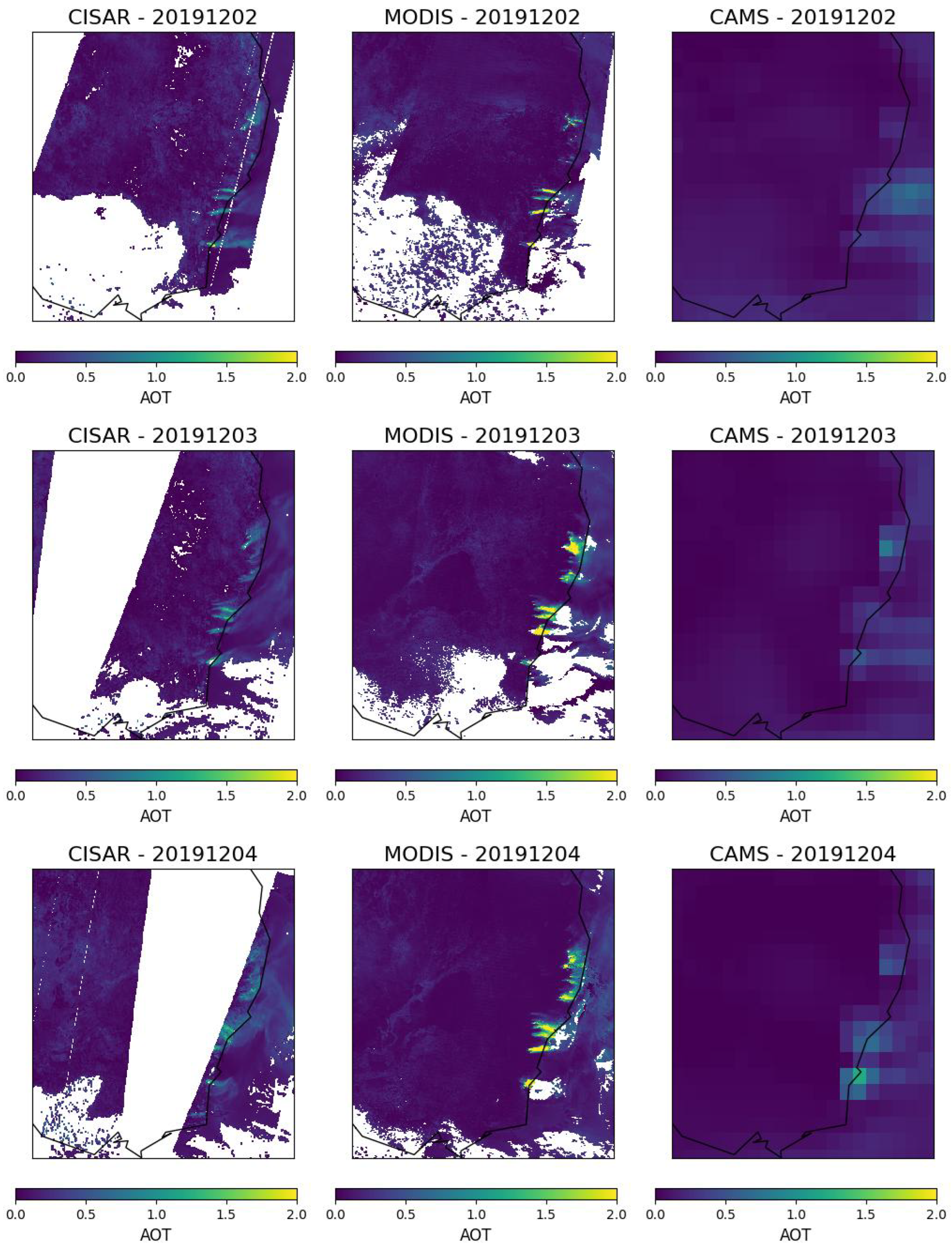

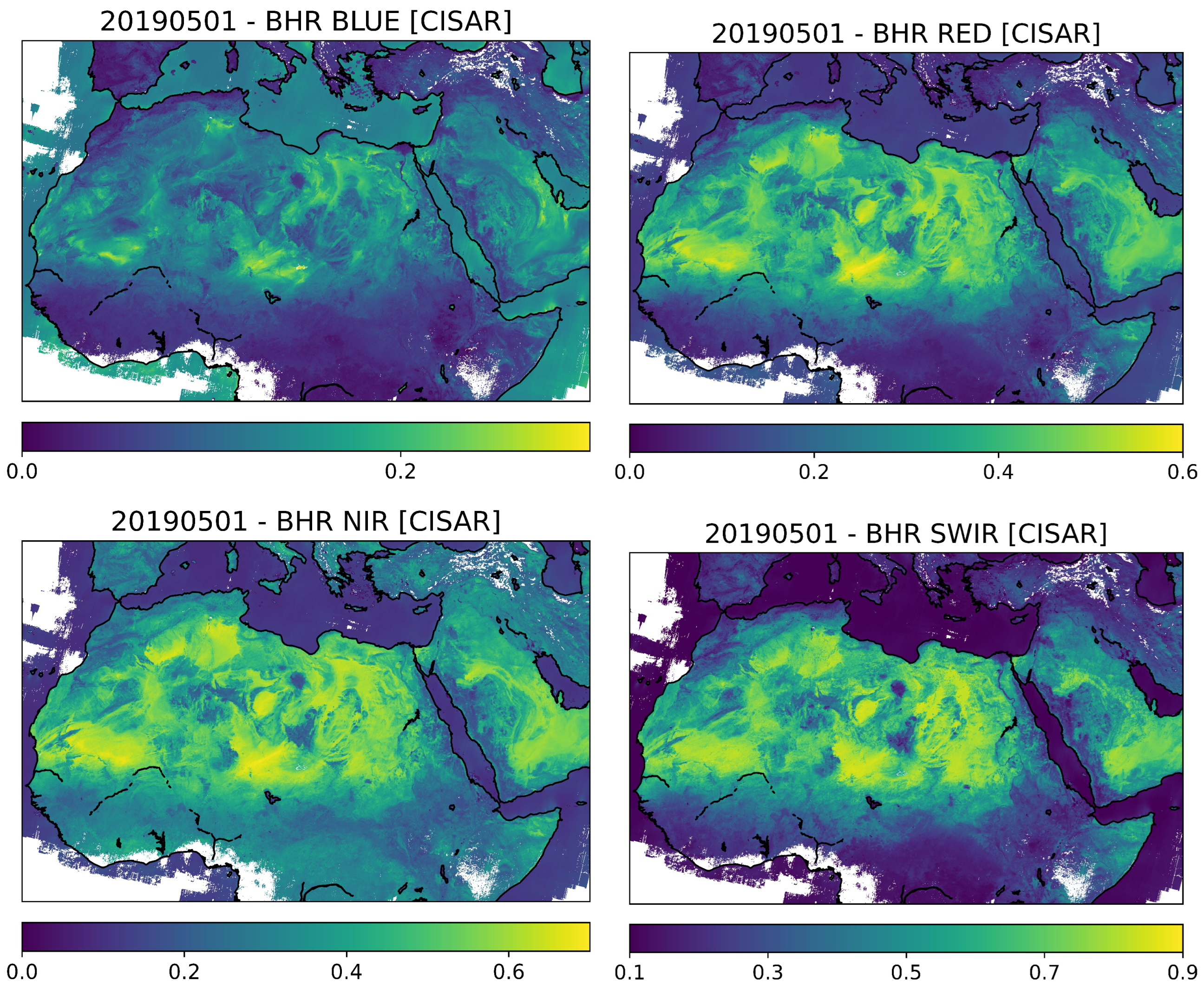

| BLUE | RED | NIR | SWIR | |
|---|---|---|---|---|
| SPOT-VGT1 | ||||
| 1.042 | 1.028 | 1.020 | 1.026 | |
| SPOT-VGT2 | ||||
| 1.036 | 1.024 | 1.013 | 1.019 | |
| PROBA-V | ||||
| ALL | 1.024 | 1.005 | 0.997 | 1.004 |
| LEFT | 1.040 | 1.005 | 0.997 | 1.001 |
| CENTRAL | 1.011 | 1.012 | 1.001 | 1.003 |
| RIGHT | 1.010 | 0.999 | 0.993 | 1.014 |
| Station | Latitude | Longitude | Land Cover | Main Aerosol Source |
|---|---|---|---|---|
| Alta Floresta | −9.87 | −56.10 | Mixed | Seasonal biomass burning |
| Venice | 45.31 | 12.51 | Water | Northern Italy pollution |
| Beijing | 39.98 | 116.38 | Urban | Extreme pollution |
| Banizoumbou | 13.55 | 2.66 | Arid | Dust |
| Alta Floresta | Venice | |||||
|---|---|---|---|---|---|---|
| VG1 | VGT2 | PROBA-V | VG1 | VGT2 | PROBA-V | |
| n | 328 | 539 | 398 | 259 | 1395 | 1039 |
| R | 0.54 | 0.69 | 0.42 | 0.61 | 0.59 | 0.51 |
| A | 0.01 | −0.03 | −0.10 | 0.02 | 0.02 | −0.01 |
| P | 0.29 | 0.21 | 0.32 | 0.17 | 0.12 | 0.13 |
| U | 0.29 | 0.22 | 0.33 | 0.17 | 0.13 | 0.13 |
| Beijing | Banizoumbou | |||||
| VG1 | VGT2 | PROBA-V | VG1 | VGT2 | PROBA-V | |
| n | 136 | 1137 | 777 | 125 | 509 | 290 |
| R | 0.49 | 0.53 | 0.63 | 0.28 | 0.60 | 0.52 |
| A | 0.15 | 0.17 | −0.03 | 0.07 | 0.10 | 0.01 |
| P | 0.56 | 0.47 | 0.37 | 0.31 | 0.31 | 0.33 |
| U | 0.58 | 0.50 | 0.37 | 0.32 | 0.33 | 0.33 |
| Water | Vegetation | Urban | Arid | |
|---|---|---|---|---|
| A | −0.019 | 0.009 | −0.000 | −0.059 |
| P | 0.138 | 0.146 | 0.191 | 0.212 |
| U | 0.139 | 0.146 | 0.191 | 0.220 |
| N | 365 | 2639 | 959 | 860 |
Disclaimer/Publisher’s Note: The statements, opinions and data contained in all publications are solely those of the individual author(s) and contributor(s) and not of MDPI and/or the editor(s). MDPI and/or the editor(s) disclaim responsibility for any injury to people or property resulting from any ideas, methods, instructions or products referred to in the content. |
© 2023 by the authors. Licensee MDPI, Basel, Switzerland. This article is an open access article distributed under the terms and conditions of the Creative Commons Attribution (CC BY) license (https://creativecommons.org/licenses/by/4.0/).
Share and Cite
Luffarelli, M.; Franceschini, L.; Govaerts, Y.; Niro, F.; De Grandis, E. Surface Reflectance and Aerosol Retrieval from SPOT-VGT and PROBA-V in the Mission Exploitation Platform Environment. Remote Sens. 2023, 15, 5109. https://doi.org/10.3390/rs15215109
Luffarelli M, Franceschini L, Govaerts Y, Niro F, De Grandis E. Surface Reflectance and Aerosol Retrieval from SPOT-VGT and PROBA-V in the Mission Exploitation Platform Environment. Remote Sensing. 2023; 15(21):5109. https://doi.org/10.3390/rs15215109
Chicago/Turabian StyleLuffarelli, Marta, Lucio Franceschini, Yves Govaerts, Fabrizio Niro, and Erminia De Grandis. 2023. "Surface Reflectance and Aerosol Retrieval from SPOT-VGT and PROBA-V in the Mission Exploitation Platform Environment" Remote Sensing 15, no. 21: 5109. https://doi.org/10.3390/rs15215109








